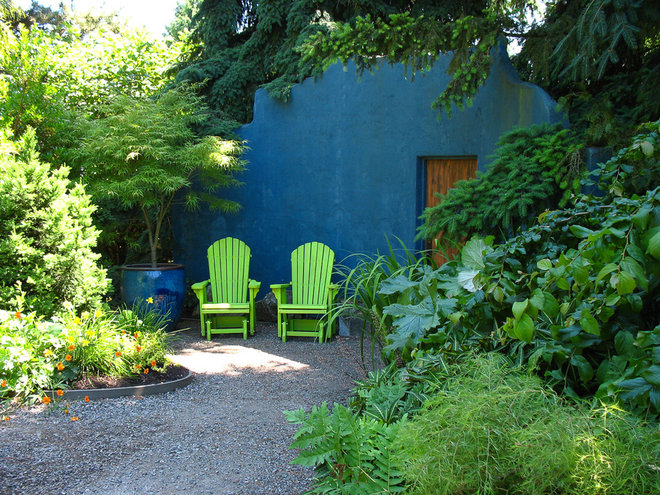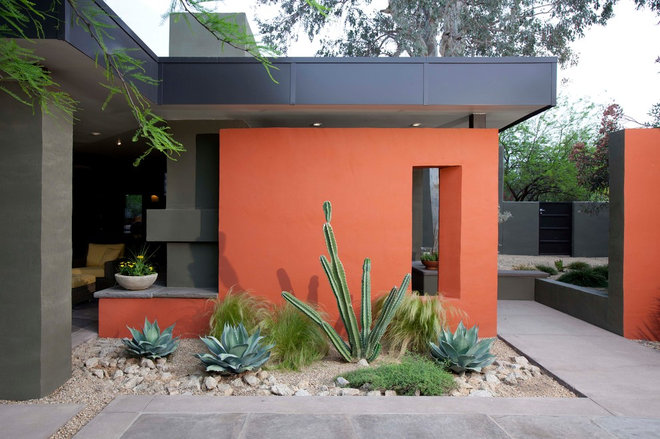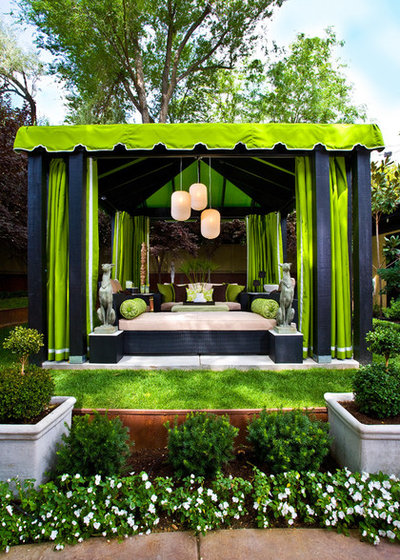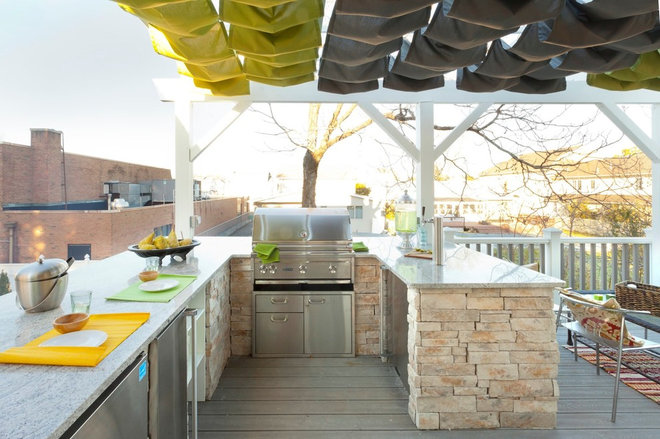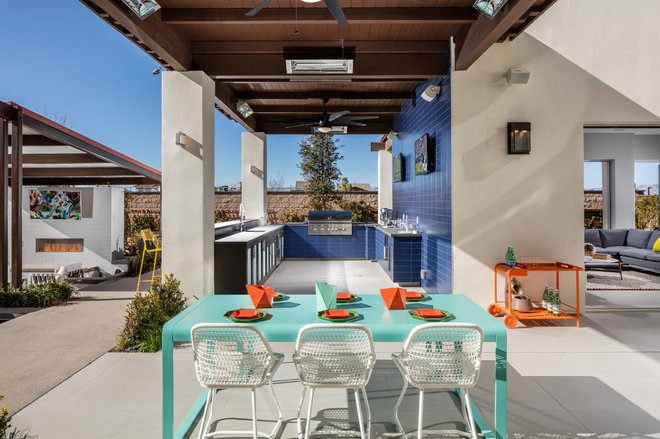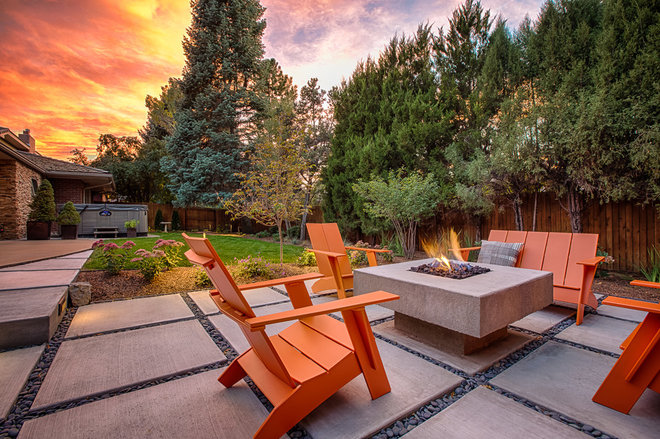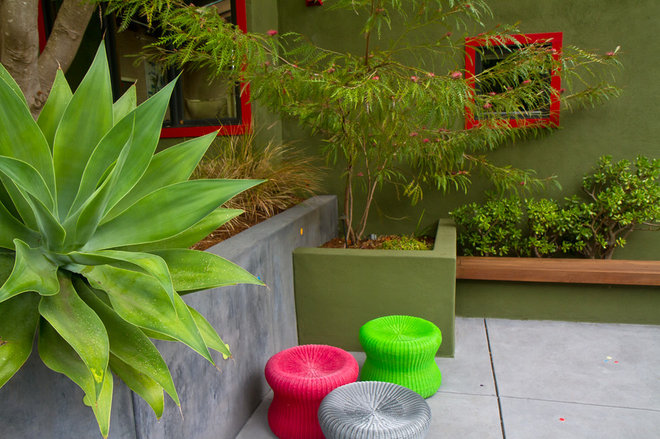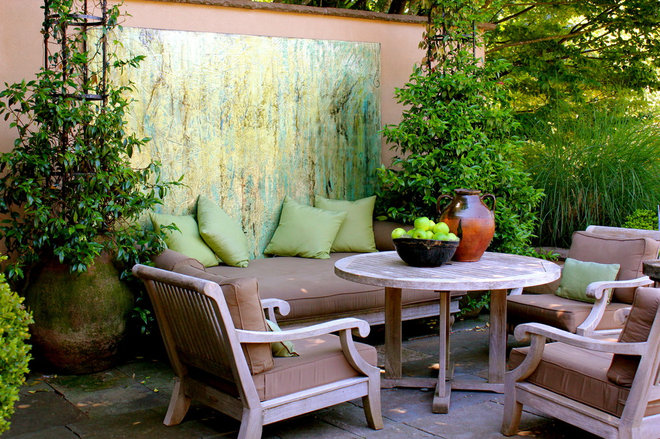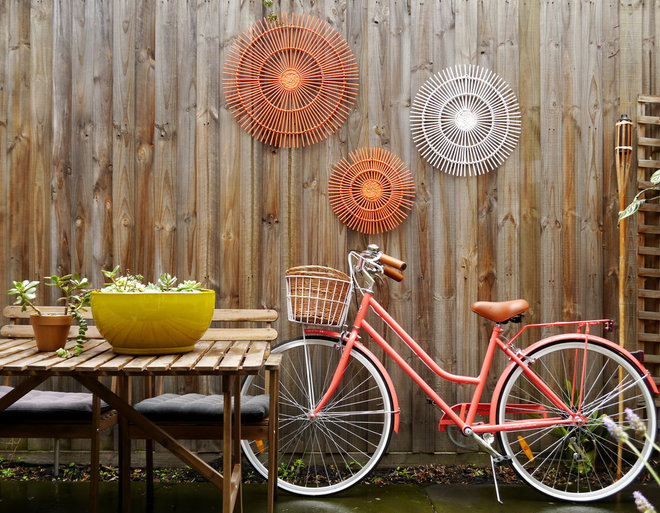
Bobby Berk: When it comes to selecting kitchen countertops for your home, there is a daunting amount of choices. We’d like to go through a few of the most popular materials to make the task of picking a countertop material a little easier based on your design preferences, application and of course budget. Here are the best kitchen countertops and why:
Natural Stone Countertops ($$-$$$)
Granite ($$-$$$):
The most popular countertop material, is available in a wide array of colors. It’s cut into long thick slabs that require few (if any) seams. Most manufacturers make single-piece countertops that can be made up to 10 ft. long. The slabs are sealed with an impregnating sealer, which makes the stone resistant to stains from everyday wear. An annual seal is required, as well as require regular care. This includes selecting and using a stone cleaner as opposed to a more abrasive chemical cleaner when caring for your countertops. Stains should be wiped up quickly. You can expect to pay anywhere from $60 to $250 a sq. ft., depending on color, brand, and fabrication.
Granite ($$-$$$):
The most popular countertop material, is available in a wide array of colors. It’s cut into long thick slabs that require few (if any) seams. Most manufacturers make single-piece countertops that can be made up to 10 ft. long. The slabs are sealed with an impregnating sealer, which makes the stone resistant to stains from everyday wear. An annual seal is required, as well as require regular care. This includes selecting and using a stone cleaner as opposed to a more abrasive chemical cleaner when caring for your countertops. Stains should be wiped up quickly. You can expect to pay anywhere from $60 to $250 a sq. ft., depending on color, brand, and fabrication.

Marble ($$$):
Marble is considered one of the most elegant and sophisticated countertop materials, and the veining intrinsic to the material is praised for its natural beauty. It is very durable, but porous, so it’s susceptible to stains. It can be polished or honed, but should be regularly sealed in order to prevent staining. Many homeowners will acquiesce to the required maintenance despite because of its beauty. $125-$250 a sq. ft.
Marble is considered one of the most elegant and sophisticated countertop materials, and the veining intrinsic to the material is praised for its natural beauty. It is very durable, but porous, so it’s susceptible to stains. It can be polished or honed, but should be regularly sealed in order to prevent staining. Many homeowners will acquiesce to the required maintenance despite because of its beauty. $125-$250 a sq. ft.

Slate ($$$):
Comes in red, gray, green, black and purple. Some types of variegated purple slate has veining and shades of contrasting colors. It is very heavy due to its high density, although it is soft, so scratches can occur. These can be buffed out with steel wool. Slat can be fabricated into sinks to match the countertop, if desired. Slate is a great option for a low maintenance lifestyle or application, as it is a non-porous material and very easy to care for. It has a naturally matte appearance, but it can be made shiny with an application of lemon oil. Slate countertops cost from $100-$200 a sq. ft., depending on color, brand and fabrication.
Comes in red, gray, green, black and purple. Some types of variegated purple slate has veining and shades of contrasting colors. It is very heavy due to its high density, although it is soft, so scratches can occur. These can be buffed out with steel wool. Slat can be fabricated into sinks to match the countertop, if desired. Slate is a great option for a low maintenance lifestyle or application, as it is a non-porous material and very easy to care for. It has a naturally matte appearance, but it can be made shiny with an application of lemon oil. Slate countertops cost from $100-$200 a sq. ft., depending on color, brand and fabrication.

Soapstone ($$):Typically dark, greenish-black or lighter green-grey. Can be fabricated into sinks to match the countertop. Soapstone is very porous, so it has to be sealed with mineral oil in order to reduce staining. Cracks can be expensive to fix, so the maintenance is important. It typically costs from $70-$100 a sq. ft.

Concrete ($$):
Pre-cast concrete is preferable to poured-in-place countertops, because they are honed, cured and sealed off site. They are typically 1.5” thick and available in slabs up to 10’ in length. The concrete mixture can be stained to a variety of colors by adding dye in the manufacturing process. This can make for some interesting finish options. Cracking is typically an issue with any concrete product, so the structure of the countertop is often fortified with mesh, rebar, or fiberglass product. Custom concrete countertops range in price from $85-100 a sq. ft.
Pre-cast concrete is preferable to poured-in-place countertops, because they are honed, cured and sealed off site. They are typically 1.5” thick and available in slabs up to 10’ in length. The concrete mixture can be stained to a variety of colors by adding dye in the manufacturing process. This can make for some interesting finish options. Cracking is typically an issue with any concrete product, so the structure of the countertop is often fortified with mesh, rebar, or fiberglass product. Custom concrete countertops range in price from $85-100 a sq. ft.

Plastic Laminate ($):
Plastic Laminate, also known as Formica, is an enduring and strong material that is made from layers of paper that are suffused with resin to form the hard surface layer. It’s available in endless colors and designs, but the matte finishes are the only ones you should specify for a countertop. Note that there are two thicknesses. The 1/16” thickness is for general purpose applications including countertops. The 1/32” is for vertical grade applications and backsplashes. It comes in sheets that range from smaller pieces at 2’x4’ up to 4’x8’. Larger wider sheets can be custom ordered from certain manufacturers. This is by far the most affordable material. You can buy pre-fabricated counters that are ready for installation and these can cost about $100 for an 8 ft. counter. Custom applications will range from $15-$25 a sq. ft.
Plastic Laminate, also known as Formica, is an enduring and strong material that is made from layers of paper that are suffused with resin to form the hard surface layer. It’s available in endless colors and designs, but the matte finishes are the only ones you should specify for a countertop. Note that there are two thicknesses. The 1/16” thickness is for general purpose applications including countertops. The 1/32” is for vertical grade applications and backsplashes. It comes in sheets that range from smaller pieces at 2’x4’ up to 4’x8’. Larger wider sheets can be custom ordered from certain manufacturers. This is by far the most affordable material. You can buy pre-fabricated counters that are ready for installation and these can cost about $100 for an 8 ft. counter. Custom applications will range from $15-$25 a sq. ft.

Wood ($$-$$$):
Wood is a traditional countertop material that can really add warmth to a space. Many people have been concerned in the past with the viability of wood as a countertop material, because of its porous nature, however wood has been found to have more anti-bacterial effectiveness than plastic as a cutting surface. It does require maintenance to keep a good seal. Polyurethane can offer good protection for a few years, but it’s aesthetically preferable for many people who prefer to accentuate the natural beauty of the wood by using less chemically synthetic mineral oil. This treatment requires more maintenance and reapplication every 4-6 weeks is a deterrent to more low-maintenance lifestyles.
Wood is a traditional countertop material that can really add warmth to a space. Many people have been concerned in the past with the viability of wood as a countertop material, because of its porous nature, however wood has been found to have more anti-bacterial effectiveness than plastic as a cutting surface. It does require maintenance to keep a good seal. Polyurethane can offer good protection for a few years, but it’s aesthetically preferable for many people who prefer to accentuate the natural beauty of the wood by using less chemically synthetic mineral oil. This treatment requires more maintenance and reapplication every 4-6 weeks is a deterrent to more low-maintenance lifestyles.
Despite woods higher degree of care, it is a great option for certain surfaces such as food prep areas, dining counters, and food chopping blocks. It is the only countertop material suggested for cutting and chopping. The most popular species of wood for countertop applications are rock maple, walnut, oak, cherry and teak. It should be protected from extra hot cookware, as it is prone to burn stains at very hot temperatures, but scratches can be sanded out.

The three forms of wood counter production include edge grain, end grain and wide plank. Edge grain are made from pieces of wood that are thin and long and glued together with the edge grain facing upwards. End grain countertops, or butcher blocks, are assembled from short, square pieces of wood with the end grain facing upwards. These are typically from 4-12” thick. Wide plank counters, the most traditional style, are made by gluing planks of wood together at the edges of the planks. These can be susceptible to warping or cracking if not properly and regularly maintained. Pre-fabricated countertops can be ordered at most lumber yards and wood dealers. 1.5” x 25” wide counters come in 8’ to 12’ lengths typically. Wood countertops vary in price depending on the species of wood, but can be comparable to natural stone and man made solid surface. Expect to pay anywhere form $35-$250 a sq. ft.
Stainless Steel ($$):
Stainless steel is beautiful, and extremely durable. It is resistant to rust and corrosion, and can withstand extreme heat (up to 800 degrees). Stainless steel countertops can be prone to scratches, so some people prefer to only use it on vertical surfaces as a backsplash. Either way, it can create a very clean, modern, industrial look, or go with something more traditional like a farm house kitchen. It can be prone to fingerprints and water stains, so it needs to be cleaned to maintain a nice appearance. You can’t use any caustic chemicals on it, including bleach cleaners, but it can be disinfected with a mixture of water and vinegar. Pre-fabricated stainless steel countertops are typically fabricated with a wood core, and can even be installed DIY, as you would with laminate. Prices range form $70-$150 a sq. ft.
Stainless steel is beautiful, and extremely durable. It is resistant to rust and corrosion, and can withstand extreme heat (up to 800 degrees). Stainless steel countertops can be prone to scratches, so some people prefer to only use it on vertical surfaces as a backsplash. Either way, it can create a very clean, modern, industrial look, or go with something more traditional like a farm house kitchen. It can be prone to fingerprints and water stains, so it needs to be cleaned to maintain a nice appearance. You can’t use any caustic chemicals on it, including bleach cleaners, but it can be disinfected with a mixture of water and vinegar. Pre-fabricated stainless steel countertops are typically fabricated with a wood core, and can even be installed DIY, as you would with laminate. Prices range form $70-$150 a sq. ft.

Ceramic Tile ($-$$):
Because of the grout lines in a ceramic tile application, many designers and builders have shifted away from tile for countertops. Tile is probably best used on backsplashes or auxiliary work surfaces such as an island, eat-at countertop, peninsulas, wet bars and butler pantries. Don’t use tile intended for wall applications, as it can easily leave cracks in your finished surface. Tile that is intended for counters or floors is best. Ceramic tile can be applied right to plywood or over laminate countertops. The best installation method is using a ¾” plywood with a ½” cement backer board. The cost will of course depend on the type of tile you select, but basic tile can be very affordable. The cost for installation will run between $30 and $50 a sq. ft. plus the cost of your tile.
Because of the grout lines in a ceramic tile application, many designers and builders have shifted away from tile for countertops. Tile is probably best used on backsplashes or auxiliary work surfaces such as an island, eat-at countertop, peninsulas, wet bars and butler pantries. Don’t use tile intended for wall applications, as it can easily leave cracks in your finished surface. Tile that is intended for counters or floors is best. Ceramic tile can be applied right to plywood or over laminate countertops. The best installation method is using a ¾” plywood with a ½” cement backer board. The cost will of course depend on the type of tile you select, but basic tile can be very affordable. The cost for installation will run between $30 and $50 a sq. ft. plus the cost of your tile.

Man-Made Solid Surface Countertops ($$-$$$):
These materials, such as DuPont’s Corian, Wilsonart’s Gibraltar, and Aristech’s Avonite, are made of 100% acrylic, 100% polyester, or a combination of acrylic and polyester. These engineered countertops have properties that make them very durable and ideal for a lot of different applications. They come in almost any color imaginable, and can be customized to almost any design, including intricate inlay patterns. They are also made to look many types of other stone, and can be fabricated into sinks to match the countertop material.
These materials, such as DuPont’s Corian, Wilsonart’s Gibraltar, and Aristech’s Avonite, are made of 100% acrylic, 100% polyester, or a combination of acrylic and polyester. These engineered countertops have properties that make them very durable and ideal for a lot of different applications. They come in almost any color imaginable, and can be customized to almost any design, including intricate inlay patterns. They are also made to look many types of other stone, and can be fabricated into sinks to match the countertop material.
Part of this category is quartz-composite materials such as DuPont’s Zodiaq, Silestone, Cambria and CaesarStone, which are just a few of the composite products on the market. Engineered stones like these are much harder and have a depth, clarity and luminance not found in other solid surfaces. Quartz composites cost slightly more than conventional man-made solid surface counters. The whole category is priced at $150-$200 a sq. ft. for solid-surface materials.


























